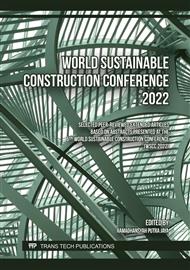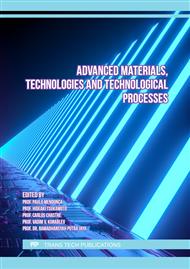[1]
C.R. Hackney, S.E. Darby, D.R. Parsons, J. Leyland, J.L. Best, R. Aalto, A.P. Nicholas, R.C. Houseago"River bank instability from unsustainable sand mining in the lower Mekong River," Nature Sustainability, 3, no. 3, pp.217-225, 2020.
DOI: 10.1038/s41893-019-0455-3
Google Scholar
[2]
P. J. M. Monteiro, S. A. Miller, and A. Horvath, "Towards sustainable concrete," Nature Materials, 16, no. 7, pp.698-699, 2017.
DOI: 10.1038/nmat4930
Google Scholar
[3]
A.Torres., M.U. Simoni, J.K. Keiding, D.B. Müller, S.O.S.E.zu Ermgassen. J. Liu. J. A.G. Jaeger, M. Winter, E.F. Lambin, "Sustainability of the global sand system in the Anthropocene" One Earth 4, 5, pp.639-650, (2021)
DOI: 10.1016/j.oneear.2021.04.011
Google Scholar
[4]
L. Koehnken, M. S. Rintoul, M. Goichot, D. Tickner, A. C. Loftus, and M. C. Acreman, "Impacts of riverine sand mining on freshwater ecosystems: A review of the scientific evidence and guidance for future research," River Research and Applications, 36, no. 3, pp.362-370, 2020.
DOI: 10.1002/rra.3586
Google Scholar
[5]
UNEP, "Sand, rarer than one thinks," Environmental Development, vol. 11, pp.208-218, 2014.
DOI: 10.1016/j.envdev.2014.04.001
Google Scholar
[6]
K. G. Santhosh, S. M. Subhani, and A. Bahurudeen, "Cleaner production of concrete by using industrial by-products as fine aggregate: A sustainable solution to excessive river sand mining," Journal of Building Engineering, 42, p.102415,2021.
DOI: 10.1016/j.jobe.2021.102415
Google Scholar
[7]
F. Y. Teo, M. M. Noh, A. A. Ghani, N. Zakaria, and C. Chang, "River sand mining capacity in Malaysia," in Proceedings of the 37th IAHR World Congress, 2017, vol. 6865, 538-546.
Google Scholar
[8]
A. Tiwari, Singh, S., & Nagar, R., "Feasibility assessment for partial replacement of fine aggregate to attain cleaner production perspective in concrete: A review," Journal of Cleaner Production, 135, pp.490-507, 2016.
DOI: 10.1016/j.jclepro.2016.06.130
Google Scholar
[9]
B. Huang, X. Wang, H. Kua, Y. Geng, R. Bleischwitz, and J. Ren, "Construction and demolition waste management in China through the 3R principle," Resources, Conservation and Recycling, vol. 129, pp.36-44, 2018.
DOI: 10.1016/j.resconrec.2017.09.029
Google Scholar
[10]
J. Liu, E. Gong, D. Wang, X. Lai, and J. Zhu, "Attitudes and behaviour towards construction waste minimisation: a comparative analysis between China and the USA," Environmental Science and Pollution Research, vol. 26, no. 14, pp.13681-13690, 2019.
DOI: 10.1007/s11356-018-2247-0
Google Scholar
[11]
S. Das, S.-H. Lee, P. Kumar, K.-H. Kim, S. S. Lee, and S. S. Bhattacharya, "Solid waste management: Scope and the challenge of sustainability," Journal of Cleaner Production, 228, pp.658-678, 2019.
DOI: 10.1016/j.jclepro.2019.04.323
Google Scholar
[12]
H. Wu, J. Zuo, G. Zillante, J. Wang, and H. Yuan, "Status quo and future directions of construction and demolition waste research: A critical review," Journal of Cleaner Production, vol. 240, p.118163, 2019.
DOI: 10.1016/j.jclepro.2019.118163
Google Scholar
[13]
S. K. Kirthika, Surya, M., & Singh, S. K., "Effect of clay in alternative fine aggregates on performance of concrete.," Construction and Building Materials, 228, p.116811, 2019.
DOI: 10.1016/j.conbuildmat.2019.116811
Google Scholar
[14]
O. Ozcan, N. Musaoglu, and D. Z. Seker, "Environmental impact analysis of quarrying activities established on and near a river bed by using remotely sensed data," Fresenius Environmental Bulletin, 21, no. 11, pp.3147-3153, 2012.
Google Scholar
[15]
G. Mitri, G. Nasrallah, and M. Nader, "Spatial distribution and landscape impact analysis of quarries and waste dumpsites," Environment, Development and Sustainability, vol. 23, no. 8, pp.12302-12325, 2021.
DOI: 10.1007/s10668-020-01169-z
Google Scholar
[16]
R. H. Crawford, D. Mathur, and R. Gerritsen, "Barriers to improving the environmental performance of construction waste management in remote communities," Procedia Engineering, 196, pp.830-837, 2017.
DOI: 10.1016/j.proeng.2017.08.014
Google Scholar
[17]
T. Xie, A. Gholampour, and T. Ozbakkaloglu, "Toward the development of sustainable concretes with recycled concrete aggregates: Comprehensive review of studies on mechanical properties," Journal of Materials in Civil Engineering, 30, 2018.
DOI: 10.1061/(asce)mt.1943-5533.0002304
Google Scholar
[18]
H. Salahuddin, L. A. Qureshi, A. Nawaz, and S. S. Raza, "Effect of recycled fine aggregates on performance of Reactive Powder Concrete," Construction and Building Materials, vol. 243, p.118223, 2020.
DOI: 10.1016/j.conbuildmat.2020.118223
Google Scholar
[19]
R. V. Silva, J. De Brito, and R. Dhir, "Properties and composition of recycled aggregates from construction and demolition waste suitable for concrete production," Construction and Building Materials, vol. 65, pp.201-217, 2014.
DOI: 10.1016/j.conbuildmat.2014.04.117
Google Scholar
[20]
D. Gao, Z. Gu, Y. Pang, and L. Yang, "Mechanical properties of recycled fine aggregate concrete incorporating different types of fibers," Construction and Building Materials, vol. 298, p.123732, 2021.
DOI: 10.1016/j.conbuildmat.2021.123732
Google Scholar
[21]
S. Nagataki, A. Gokce, T. Saeki, and M. Hisada, "Assessment of recycling process induced damage sensitivity of recycled concrete aggregates," Cement and Concrete Research, vol. 34, no. 6, pp.965-971, 2004/06/01/ 2004.
DOI: 10.1016/j.cemconres.2003.11.008
Google Scholar
[22]
B. Li, S. Hou, Z. Duan, L. Li, and W. Guo, "Rheological behavior and compressive strength of concrete made with recycled fine aggregate of different size range," Construction and Building Materials, 268, 121172, 2021.
DOI: 10.1016/j.conbuildmat.2020.121172
Google Scholar
[23]
B. E. 12350-2-2009., " Testing Fresh Concrete. Slump-test," (2009).
Google Scholar
[24]
BS EN 12390-3., "Testing hardened concrete - Part 3: Compressive strength of test specimens. ," (2009).
Google Scholar
[25]
B. 1881-122, "Concrete Testing Water Absorbtion.," 2009.
Google Scholar
[26]
A. O. Dawood, H. AL-Khazraji, and R. S. Falih, "Physical and mechanical properties of concrete containing PET wastes as a partial replacement for fine aggregates," Case Stud. Constr. Mater., vol. 14, p. e00482, 2021, doi: 10.1016/j.cscm. 2020.e00482.
DOI: 10.1016/j.cscm.2020.e00482
Google Scholar
[27]
M. Ju., K. Park and W.J. Park " Mechanical behavior of recycled fine aggregate concrete with high slump properties in normal- and high-strength," Int. Journal of Concrete Structures and Materials, 13 (61) 2019.
DOI: 10.1186/s40069-019-0372-x
Google Scholar
[28]
A. M. Neville, Properties of concrete. Pearson Education Limited, London, 2011.
Google Scholar



